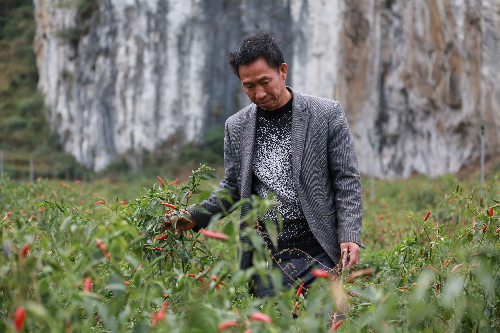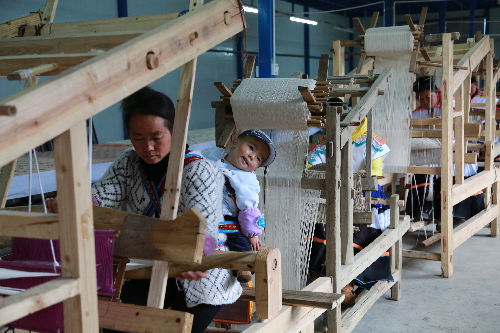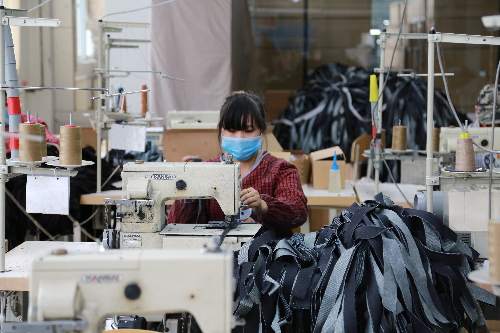
New measures are being devised to raise the living standards of the country's poorest groups by giving new life to moribund villages in the rural areas. Li Yang and Yang Jun report from Bijie, Guizhou province.
Three years ago, five "left-behind" children died after they crawled into a refuse container on a freezing winter day and lit a fire to keep warm, but were overcome by carbon monoxide fumes.
The deaths occurred in Bijie, a city in Guizhou province, where in June, four siblings, one boy and three girls ages 5 to 14 committed suicide by drinking pesticide at their rundown home while their parents were working as migrant workers in faraway Guangdong province.
The cases highlighted the plight of left-behind children in China's underdeveloped rural areas, and the pressures that force their parents to move to cities for work, leaving the children with their grandparents.
Bijie, located in a mountainous region and covering an area roughly the same as Belgium, has 8.8 million registered residents, many of them members of one of the area's 44 ethnic groups. However, about 3 million Bijie natives earn their livelihoods in prosperous coastal regions, such as the Pearl River Delta and the Yangtze River Delta, resulting in 500,000 left-behind children.
At the end of August, more than 1.5 million people in the city were living below the World Bank's designated poverty level, which was $1.25 per person per day before mid-October, but was recently raised to $1.90. Two years ago things were even worse, and the number was 2.5 million.
In truth, Bijie's poor are just a fraction of the 70 million people across China who exist on less than $1.25 a day. The problem is so acute that last week the nation's top leaders attended a national poverty alleviation work conference in Beijing to discuss measures to lift rural residents out of poverty.
In a statement released after the conference, the leaders pledged to mobilize all resources and powers to eradicate the problem within five years, and the governors of the 22 regions most in need of poverty-alleviation measures signed "assignment books" with the authorities that clearly defined areas of accountability and responsibility for them and their subordinates.
The number of people in Guizhou living in poverty fell to about 5 million by the end of September this year, from 11.49 million in 2011. The remaining needy 5 million will be the hardest to help because they are scattered across a large mountainous area, according to Ye Tao, director of Guizhou's provincial poverty-alleviation office.
Legal obligations
"Grassroots governments in places like Bijie need to compile files on every poor family, and take customer-tailored measures to help every household find a way out of poverty. A local civil servant should be responsible for every poor family in Guizhou," he said. "Local governments must fulfill their legal obligations to care for people who are losing the ability to take care of themselves, and allow easier access to basic social services."
Since the late 1970s, more than 700 million people in China have been lifted out of poverty, making the country the first developing economy to meet the UN's Millennium Development Goal of halving the number of people living in poverty by 2015.
Instead of using public funds to directly support poorer regions, the central government urged local governments in places such as Bijie to attract investors to labor-intensive industries such as agriculture and tourism that provide a good fit with local conditions and create large numbers of jobs closer to people's homes.
While he welcomed the moves, Huang Chun, director of Bijie's poverty-alleviation department, said local authorities should help the needy to obtain loans from local banks so they can develop business ideas, such as agricultural and ethnic artwork cooperatives and tourist-oriented family inns and restaurants.
"There are 450,000 poor families in Bijie at present. Our experience shows that it costs about 10,000 yuan to lift one family out of poverty, provided the money is invested in sustainable programs, such as raising pigs, sheep and chicken. That means we will need 4.5 billion yuan," Huang said. "The government has to turn to banks, intergovernmental and social organizations, and also attract funds from private individuals and enterprises to overcome the funding shortfall."
In 2009, Zhang Xianglun, a resident of Hetaozhai village in Bijie, used subsidized loans to buy and raise egg-laying hens, and now makes a net profit of 300,000 yuan ($47,000) a year. He employs about 20 villagers to take care of the henhouses, and is considering increasing the number of broiler chickens, which are mainly used to provide meat.
"The government provided me with loan guarantees and an interest subsidy as well as technical support," Zhang said. "If not for that support, I would never have had the opportunity to start the business from zero."
In 2002, the Revolutionary Committee of the Chinese Kuomintang, a political advisory party, provided 20 million yuan to help Hetaozhai's residents transform their thatched houses into brick-and-tile dwellings, build 416 storage areas known as "water cellars", along with asphalt roads and a village primary school.
Yuan Hejun, the village head, said greater reliance on private enterprise could turn fortunes around: "There are still 190 left-behind children in the village. I hope more and more villagers can start their own businesses, like Zhang Xianglun, so the children and their parents can live together as families."
Shen Yuhan, one of the 16 teachers at the village school, monitors the children's conditions. "I visit the home for left-behind children at least once a month, to check on the living conditions and learn about the difficulties the children are experiencing in their lives. I then report my findings to the village committee," she said.
There are more than 440 students at the school, and nearly half of them are left-behind and live with their grandparents, many of whom were among the first-generation of migrant workers in the 1990s.
'Surrogate parent'
Shen, who has worked at the school since she graduated from a local university in 2007, said life in the mountains is decades behind modern city life, but she is happy to help more children attend middle school, especially those from isolated areas, such as the student whose home is two and a half hours away by foot.
"Some of the left-behind children see me as a surrogate parent, and the feeling of being trusted gives me a strong sense of responsibility," she said.
In 2011, the World Bank provided 7 million yuan to help the residents of Luojiazhai, a village of the Miao ethnic group near Hetaozhai, to start a collective for embroidery and weaving.
Last year, the collective produced goods valued at about 4 million yuan, and the number of members has grown from 39, mostly women, in one village in 2011, to 234 people from seven ethnic groups in seven villages.
"I can take care of the kids and work for the cooperative, earning 2,200 to 4,000 yuan a month depending on how productive I am," said Li Xuelian, who was operating a traditional wooden loom while carrying her grandson on her back.
A similar government-funded cooperative run by Miao people that specializes in dyed batik cloth and has been operating since 2009 has been bolstered by a rise in the number of tourists at a global geo-park in Bijie, which is home to the famous Zhijindong Cave. More than 200 young women work at home while taking care of their children and families and sell their products to the cooperative.
Unlike Hetaozhai or Luojiazhai, Shaowo village has about 14 hectares of farmland, a rare sight in the valleys of the mountainous region. In 2012, a vegetable business from Weifang, Shandong province, spent 20 million yuan to build greenhouses and the Bijie government contributed 10 million yuan to build the infrastructure for the cultivation of bamboo fungus mushrooms, peppers, kidney beans, purple cabbage and broccoli.
Song Yuan, a local resident who is the project's general manager, said more than 100 villagers have now returned from distant cities to work in the greenhouses, and many have become shareholders by allowing crops to be sown on their land.
One of the worker/shareholders, Wang Jiayi, 54, spent more than 10 years in Kunming, Yunnan province, and Xiamen, Fujian province, doing "all kinds of work that urban residents don't want to do themselves".
"I can make 100 yuan a day here. More important, it takes me only five minutes to walk home," he said. "At the end of every year, I get a dividend. Before, I was begging my boss to pay my wages in full."
His neighbor Wang Gang, regarded as the most-gifted entrepreneur in the village, is an exception because he runs his own business. "I would not like to be employed (by someone else)," he said, pointing out that he was happy to rent out his land to the company, but refused to work for it. Instead, he runs a family inn, a fish pond, a small eatery and a distillery, where he and his wife produce homemade liquor.
"I have noticed that the organic food, scenic tourism and ethnic cultures here are more attractive to a growing number of 'self-drive" tourists and backpackers now than they were three years ago," he said.
Problematic development
Yet, the development of industries in the backward places such as Bijie is still problematic.
Li Zhongyi, president of Muye Agricultural Development Co in Zhijin county, hails from Weifang. Since June last year, he has invested more than 60 million yuan to build a pig farm, a goose farm and fund an orchard on the mountain.
"Land is not a problem in Bijie, but money is," Li said. A lack of ready collateral meant he was unable to secure loans from rural banks, so the local government promised to provide him with loan guarantees and 30 percent of the cost of building his workshops. However, the authorities now say the policy has changed and refuse to provide the money.
"I appreciate the fact that government has built a road up the mountain to my farm. But if not solved in time, the lack of financial support will throttle my business soon," Li said.
An Taimin, a county spokeswoman of Zhijin, said many new opportunities have been brought by companies from outside of the area. "The Party chief of Zhijin county is from Shandong, and he invites many businessmen from his hometown to visit and invest in Bijie. Without that connection, it would be difficult to attract investment and technology from the coastal regions."
In 2012, Qingdao Daheyongan Garment Co from Shandong set up a factory on the outskirts of Zhijin, and last year, it produced 8.27 million pairs of jeans, worth 650 million yuan. About 97 percent of the factory's products are exported to developed countries under brands such as Levi's, Zara, Uniqlo and H&M.
Duan Tongxing, director of the factory office, predicted that this year production will rise to 12 million pairs of jeans, worth 1 billion yuan.
"The bottleneck is that we cannot find enough workers to fill our rapidly expanding workshops," Duan said. The factory's three workshops employ 3,500 local workers, but several nearby workshops are standing idle, despite an average monthly wage of 3,500 to 4,000 yuan, and the lure of free dormitories, three free meals a day, and a discount offered to workers who buy houses developed by the factory in the center of the county.
According to Duan, most of the company's workers are between 30 and 45 years of age. "Young migrant workers from Bijie would rather go to big cities and earn less money as waiters, instead of working at home. They want to see the world, and they believe that there are more opportunities in the big cities," he said.
The factory has three buses that constantly travel around Bijie as part of a recruitment drive.
"Half of our energy is spent on production and sales, the other half is spent looking for workers," Duan said.
Contact the writers at liyang@chinadaily.com.cn
 |
|
Wang Jiayi, 54, works at the pepper farm of an agricultural cooperative in Shaowo village, Bijie, Guizhou province, on Nov 25. Wang is one of an increasing number of villagers who have returned home after working in big cities for many years. Photos by Yang Jun / China Daily |
 |
|
Li Xuelian, 46, operates a traditional wooden loom while carrying her grandson on her back at an embroidery and weaving collective in the Luojiazhai Miao eth-nic village in Bijie, on Nov 25. |
 |
|
A woman works at a factory of Qingdao Daheyongan Garment Co in Zhijin county, Guizhou, on Nov 26. The factory produces jeans for global brands such as Levi Strauss and Zara. |